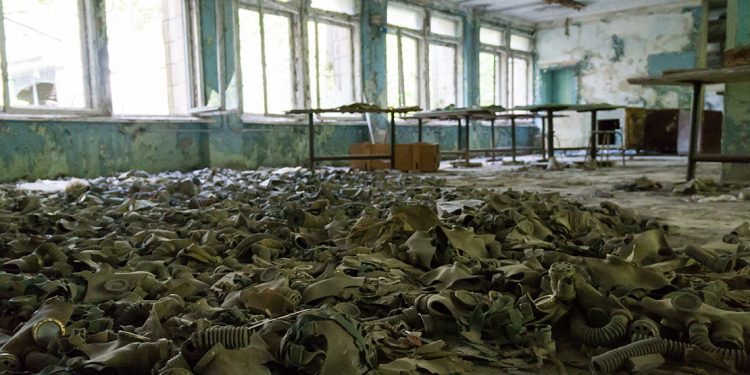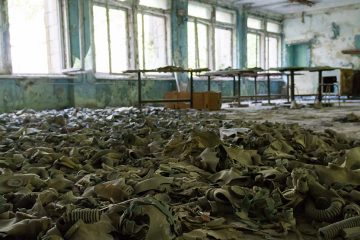
What Is Dark Tourism?
The world of dark tourism was recently made popular thanks to a Netflix documentary series called “Dark Tourist” where New Zealand journalist, David Farrier, dives deep into this subset of tourism. In the series’ eight episodes, David and the crew travel to astonishing, morbid and sometimes dangerous places around the world, highlighting these strange tourist destinations.
I was immediately hooked and wanted to know more about this unusual division of tourism. Why were people traveling to the corners of the Earth to put themselves in risky situations? How many other dark destinations were out there? Do popular and well-known historical sites count? What exactly is dark tourism?
Dark tourism consists of traveling to locations and destinations around the world that are associated with death, tragedy, destruction or all of the above. These are often natural disaster sites, memorials for historic tragedies, abandoned locales and destinations with undesirable reputations.
Due to it’s dark and occasionally horrific nature, dark tourism is also referred to as grief tourism, black tourism or Thanatourism — derived from the ancient Greek word Thanatos for the personification of death — although this term is rarely used.
Here are some of the morbid and occasionally horrific destinations around the world that should be on any dark tourist’s bucket list.
Chernobyl & Pripyat Town, Ukraine
Yes, you read that right. The Chernobyl power plant and abandoned town of Pripyat are open for tours. Not only that, but there are multiple tours to choose from depending on budget, which parts you’re interested in seeing, and how much time you have to explore. Tour companies offer excursions ranging from a single day through to a full week.
Chernobyl is the disaster site of a catastrophic nuclear accident in April 1986; the most disastrous in history. Despite dozens of people in Pripyat reporting illness only hours after the explosion, the town was not evacuated until over 36 hours later, exposing thousands of people to high levels of radiation. To this day experts are unsure of the final death toll.
Oradour-sur-Glane (Old Town), France
The old town of Oradour-sur-Glane is a “unique and sombre experience” according to one review on TripAdvisor. There is no cost to visit the village but tourists should know that it isn’t a place to be enjoyed, and is instead is a sobering memorial to the horrific events of June 1944.
Rusted bicycles, old sewing machines and the shells of old cars lay among the rubble of crumbling stone buildings in what was once a quaint French town. On June 10 of 1944, over 640 people, including women and children, were massacred by German soldiers. The village’s churches and barns were set on fire and left to burn. There was only one survivor of the brutal attack.
Kosovo tourism has plenty to offer visitors — picturesque towns, idyllic countryside, thriving nightlife and lovely people are just the beginning.
Balaclava Ghost Town, Canada
While not officially a tourist site, this Canadian ghost town is described as being “picture perfect” due to its row of dilapidated buildings. The focus of Balaclava, once a successful lumber town, is an old sawmill that was originally built in 1855 and is the site of one of the last water-powered sawmills to run in Ontario. Much of the original mill was destroyed in the 1930s by a massive fire but was quickly rebuilt.
The town is still home to a few residents, however most of its occupants left in the 1960s. Due to the depletion of timber in the region, it was no longer economical to keep the mill in operation. This left Balaclava’s general store, blacksmith shop, hotel, dam and sawmill neglected to fade away.
Murambi Genocide Museum, Rwanda
This may possibly be one of the darkest and most shocking destinations to visit. If you’re interested in dark tourism, the Murambi Genocide Museum is a must-see. But be warned — it’s not something everyone can stomach.
The gut-wrenching memorial starts with short films and information panels before leading you outside to view some of the mass graves. The tour then takes you into rooms — initially intended to be classrooms in the technical college — where hundreds of preserved corpses line the wooden racks. The partially decomposed bodies have been exhumed and mummified with powdered lime.
The victims of the massacre are still in the positions in which they died; toddlers and children with arms outstretched or covering their eyes. It’s a heart-wrenching and powerful reminder of the devastating event.
Karosta Prison, Latvia
Karosta Prison is the only military prison in Europe that is open to tourists and they have several excursions to choose from, many of which have a minimum age limit. Dark tourists will likely be fond of the “Behind Bars” option as this will give you the opportunity to experience the prison as one of the inmates.
All participants must sign a release form agreeing to the conditions of prison life – including verbal abuse, death threats, hard labor and warning gunfire – before applying for their experience behind bars.
Karosta Prison was built around 1900 and was primarily used as a Nazi and Soviet military prison; one from which nobody ever escaped. Many prisoners were sentenced to death within the prison which may be why it is said to be haunted. The prison closed its doors as a penitentiary in 1997. In addition to the tours and excursions, the Karosta Prison has been transformed into a ‘hotel’ of sorts where guests can spend the night.
Whether you're looking for a family vacation, a romantic getaway or a historical excursion these are the 5 best Mediterranean cruises out there.
Auschwitz-Birkenau Memorial, Poland
While I’m sure this historical site doesn’t need an explanation, it’s one of the busiest tourist spots on our list of dark tourism destinations. Auschwitz was that largest concentration camp and extermination centers run by German Nazis. Over 1 million men, women and children were imprisoned and sent to their deaths here between 1940 and 1945.
Tours range from two-and-a-half to six hours and should be reserved online at least one month in advance. Most guided tours of the Auschwitz memorial and museum include the original camp buildings, the unloading platform, and the ruins of gas chambers and crematoria.
Atomic Lake (Lake Chagan), Kazakhstan
Lake Chagan was recently deemed safe enough to swim in! This is excellent news for those dark tourists who are interested in sticking their toes into the Atomic Lake in Kazakhstan.
In the 1960s, the Chagan test was intended to analyze the application of using nuclear explosions to create reservoirs. A 140-kiloton nuclear device was placed in a deep hole along the Chagan River. The blast created a crater over 1,300 feet wide and about 330 feet deep which was then filled with river water.
Although most of the fallout was contained to the general area of the test-site, the blast produced a measurable radioactive plume. As a result, the radiation levels of the water are well beyond consumable levels.
The lake is still radioactive, but the levels continually fall as time passes. Would you be brave enough to go for a dip?
National Atomic Testing Museum, USA
Las Vegas is home to many a strange and bizarre sight, but dark tourists will be drawn to the National Atomic Testing Museum in Nevada that tells the story of America’s nuclear weapons testing. The sobering museum boasts 8,000 square feet of exhibits and is home to over 12,000 artifacts including personal atomic weapons, a large nuclear reactor and a replica of the Control Point where countdowns were conducted before each detonation.
The museum documents 70 years of nuclear testing beginning in January of 1951 at the Nevada Test Site through to present day. Exhibits also depict the end of the Cold War, the beginning of the Global War on Terror, and a Ground Zero Theater simulation of an above-ground nuclear test.
Fishers' Loft Inn B&B maintains look and feel of charming Bonavista Peninsula Bed and breakfast travelers will find more than they bargain for in a B&B...
Eastern State Penitentiary, USA
The Eastern State Penitentiary in Philadelphia opened its doors in October of 1829, though parts of its original structure were built and operating in the late 1700s. The penitentiary was once the most famous and expensive prison in the world but now is a crumbling, haunting reminder of what it once was.
Eastern State Penitentiary once housed some of America’s most notorious criminals including Freda Frost, William Francis “Slick Willie” Sutton and Al Capone. One of the prison’s most popular exhibits is the cell that mob boss Al “Scarface” Capone called home for eight months; a cozier site than you would find in the penitentiaries of the modern world.
There are two ways to experience Eastern State Penitentiary. Year-round the penitentiary offers day tours, school tours and site rentals for events or even weddings if you’re so inclined! In the fall, they open the doors at night and become a massive haunted house suitably called Terror Behind the Walls.
Dark tourism is an area of tourism that isn’t for the sensitive or faint of heart as it ranges from grim museum exhibits to downright horrific experiences. However, some of the appeal of dark tourism is how it can serve as a shocking and gut-wrenching reminder of the world’s brutal history that isn’t to be forgotten.
